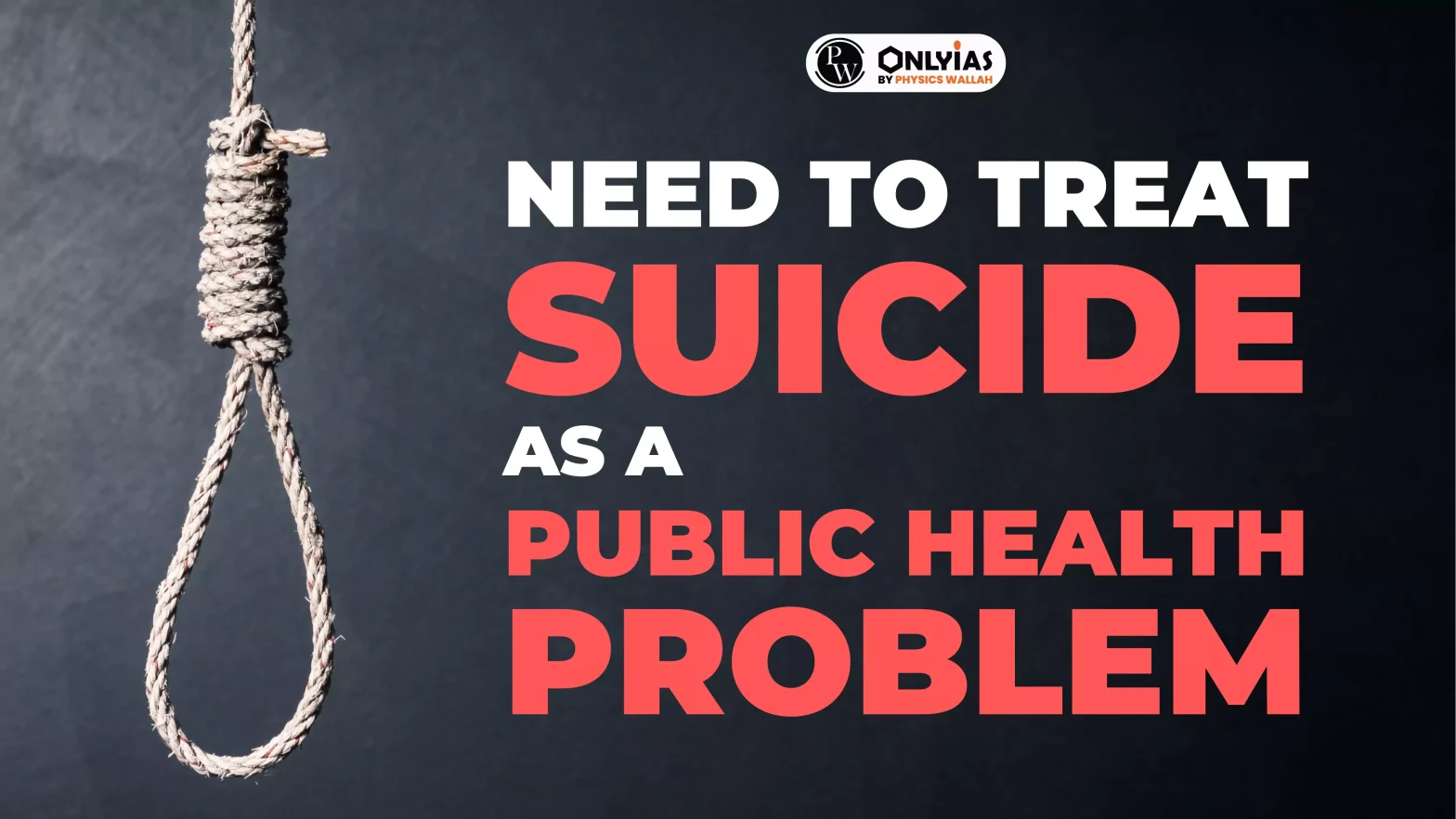Suicide is a profoundly distressing problem impacting people, families, and communities globally, with approximately 700,000 deaths annually. In India, which has one of the highest suicide rates worldwide, there were around 170,000 suicide deaths (12 per 100,000 individuals) in 2022.
Need for a Comprehensive Approach
- Complexity of Issue: Suicide is a complex health issue that is often primarily associated with anxiety and depression. However, treating it solely as a mental health issue is inadequate and reflects a developed-country perspective based on Western knowledge.
- Broader Risk Factors: In developing countries, including India, suicide risk factors include a range of social issues beyond mental health disorders. Financial hardship, fractious family relationships, domestic violence, childhood trauma, bullying, negative peer pressure, substance abuse, and lack of access to healthcare are significant contributors to the risk of suicide. Thus, suicide must be recognized as not only a mental health issue but also a social, governance, and public health issue and addressing will require a multi-faceted approach.
Suicide Prevention
- Expanding the Focus: While mental health remains a crucial aspect of suicide prevention, as highlighted by the National Mental Health Programme, addressing broader societal issues is equally important. Factors such as poverty, social inequality, caste, gender inequity, and intergenerational discord(such as the infrequent interactions between grandchildren and grandparents) are significant contributors to suicide risk.
Enroll now for UPSC Online Course
Facts About Suicide Rates and Contributing Factors
Gender Disparities
- Globally, men have higher suicide rates than women. However, in India, the suicide rate among women is estimated to be double the global average and is the leading cause of death for women aged 15-39.
- Suicides among young women often reflect oppressive societal pressures, unmet needs for support, and mental health issues.
Unique Challenges for Women
- Women face distinct challenges, including gender-based violence, body image issues related to feelings of inferiority, and academic or career pressures, such as societal expectations to marry by certain timelines.
- These factors contribute to feelings of hopelessness among women.
While men also experience significant pressure, it differs, often focusing on early career establishment and job stability. This pressure highlights the lack of a supportive environment for both genders.
High-Risk Groups
- Suicides are notably high among farmers and students, but the majority of suicide deaths occur in the 15-39 age group, which includes students, workers, job seekers, and housewives.
- There is a lack of discussion and debate about suicides in other groups beyond students and farmers, indicating gaps in addressing broader sections of the population.
|
- Need for detailed Data Collection: Right now, there is a lack of data. To truly understand the burden of suicide and develop effective prevention strategies, we need better data.
- Our understanding of suicide deaths in India mostly comes from data collected by the police and reported by the National Crimes Record Bureau (NCRB). Since suicide deaths are considered unnatural deaths, this data is not in a standardized format, making compilation and research difficult.
- Data can be improved through effective collaboration between the police and health departments on the format to be used. This will enhance our understanding of the dimensions, determinants, and dynamics of suicide in the population. Such improvements can guide effective prevention efforts and save further lives.
- Improving Data Interpretation: In addition to improved data collection, appropriate interpretation of the available data within its limitations is crucial.
- Reporting on just a few groups, such as suicides among students in Kota, Rajasthan, does not provide data for the entire student community and thus only offers a limited understanding of what is happening in the community at large.
- If the issue is severe, analyzing detailed data can help identify which groups of students are particularly at risk. However, it’s important not to generalize based on just one group. Instead, a thorough approach is needed to understand the problem fully.
- Media reports often highlight anecdotal stories, which serve as alerts rather than comprehensive estimates. This results in a limited understanding of the broader issues at hand.
- Analysing Risk Factors: The NCRB report does not provide a direct understanding of risk factors by occupation.
- For example, it does not reveal if students are taking their lives due to exam pressure, bullying, stress, relationship issues, or other factors, but assumptions can be made based on the age of the person who died by suicide. Understanding these reasons is crucial for better research and targeted intervention.
- Role of Conversation and Support Systems: One of the most powerful tools in suicide prevention is conversation. Talking openly about suicide can help break down the stigma that often surrounds the topic, making it easier for individuals to seek help.
- Family Support: This is especially crucial within families, where open and honest communication can be lifesaving. Families play a vital role in providing emotional support, recognizing warning signs, and encouraging loved ones to seek help. Creating a supportive family environment where everyone feels safe to express their feelings can significantly impact suicide prevention.
- Comprehensive Prevention Strategies
- Training and Resources: To effectively prevent suicide, those in positions to help, such as teachers, employers, and healthcare providers, need better training and resources for crisis management.
- Strengthening Community Connections: Strengthening community connections is also essential, as it helps identify and support individuals who may be vulnerable. Social isolation is a significant risk factor, and fostering a connected and supportive community can make a crucial difference.
Check Out UPSC CSE Books From PW Store
Conclusion
Without accurate and comprehensive data, we will continue to fight this battle against suicide and its prevention in the dark. Effective strategies require robust community engagement, targeted research, and investment in data collection to illuminate the true extent of the issue and guide impactful interventions.
![]() 12 Sep 2024
12 Sep 2024

